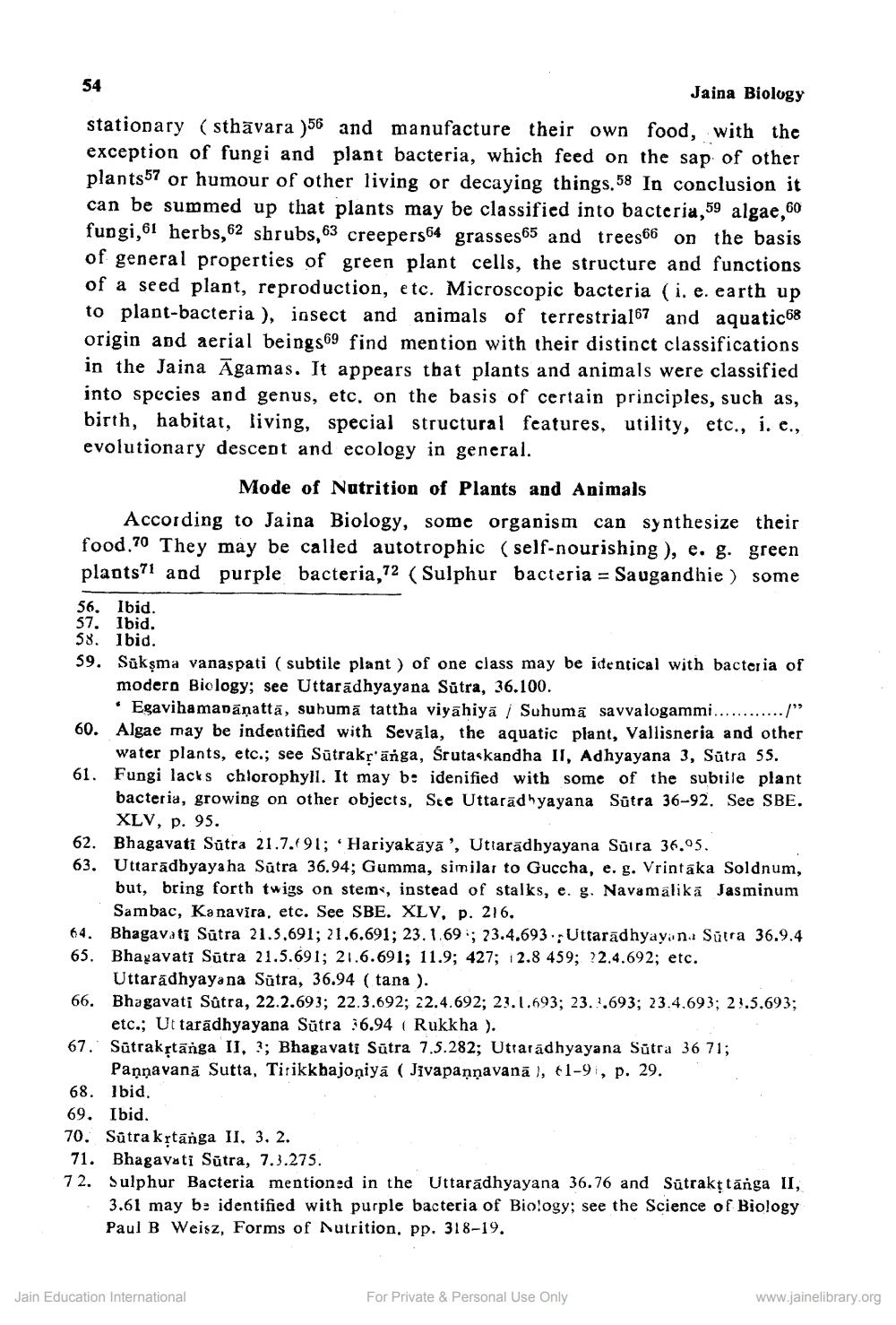________________
54
Jaina Biology stationary (sthāvara )56 and manufacture their own food, with the exception of fungi and plant bacteria, which feed on the sap of other plants57 or humour of other living or decaying things. 58 In conclusion it can be summed up that plants may be classified into bacteria,59 algae, 60 fungi,61 herbs,62 shrubs, 63 creepers64 grasses 65 and trees66 on the basis of general properties of green plant cells, the structure and functions of a seed plant, reproduction, etc. Microscopic bacteria (i. e. earth up to plant-bacteria ), insect and animals of terrestria167 and aquatic68 origin and aerial beings69 find mention with their distinct classifications in the Jaina Āgamas. It appears that plants and animals were classified into species and genus, etc. on the basis of certain principles, such as, birth, habitat, living, special structural features, utility, etc., i. e., evolutionary descent and ecology in general.
Mode of Nutrition of Plants and Animals According to Jaina Biology, some organism can synthesize their food.70 They may be called autotrophic (self-nourishing ), e. g. green plaots71 and purple bacteria,72 (Sulphur bacteria = Saugandhie ) some
56. Ibid. 57. Ibid. 58. Ibid. 59. Sūkşma vanaspati (subtile plant) of one class may be identical with bacteria of
modero Biology; see Uttarādhyayana Sūtra, 36.100.
• Egavihamanāņattā, suhumā tattha viyahiyā | Suhumā savvalogammi............/" 60. Algae may be indentified with Sevāla, the aquatic plant, Vallisneria and other
water plants, etc.; see Sūtrakr'ānga, śrutaskandha II, Adhyayana 3, Sūtra 55. Fungi lacks chlorophyll. It may b: idenified with some of the subtile plant bacteria, growing on other objects, Ste Uttaradhyayana Sūtra 36-92. See SBE.
XLV, p. 95. 62. Bhagavati Sūtra 21.7.191; * Hariyakaya', Uttaradhyayana Sūtra 36.95. 63. Uttaradhyaya ha Sutra 36.94; Gumma, similar to Guccha, e. g. Vrintāka Soldnum,
but, bring forth twigs on stems, instead of stalks, e. g. Navamalika Jasminum Sambac, Kanavira, etc. See SBE. XLV, p. 216.
Bhagavati Sūtra 21.5.691; 21.6.691; 23. 1.69; 23.4.693., Uttaradhyayon. Sūtra 36.9.4 65. Bhayavati Sūtra 21.5.691; 21.6.691; 11.9; 427; 12.8 459; 22.4.692; etc.
Uttaradhyayana Sūtra, 36.94 (tana ). 66. Bhagavati Sutra, 22.2.693; 22.3.692; 22.4.692; 23.1.693; 23.4.693; 23.4.693; 25.5.693;
etc.; Uttaradhyayana Sūtra 36.94 Rukkha ). 67. Sūtraktänga II, ?; Bhagavati Sūtra 7.5.282; Uttaradhyayana Sūtra 36 71;
Pannavana Sutta, Tirikkhajoniya (Jivapaņņavanā), 11-9, p. 29. 68. Ibid. 69. Ibid. 70. Sūtra krtānga II, 3. 2.
71. Bhagavati Sūtra, 7.3.275. 72. Sulphur Bacteria mentioned in the Uttaradhyayana 36.76 and Sūtrakttānga II,
3.61 may b: identified with purple bacteria of Biology; see the Science of Biology Paul B Weisz, Forms of Nutrition, pp. 318-19.
10.
Jain Education International
For Private & Personal Use Only
www.jainelibrary.org




